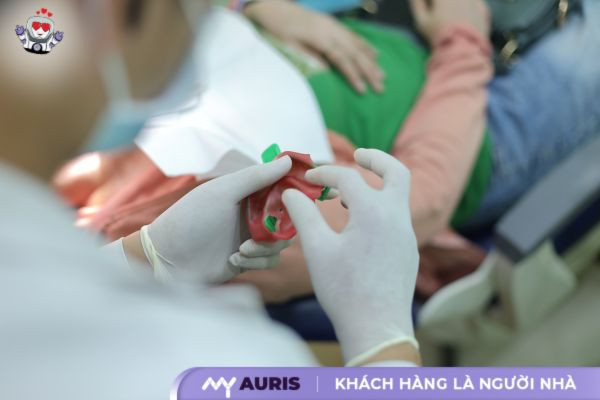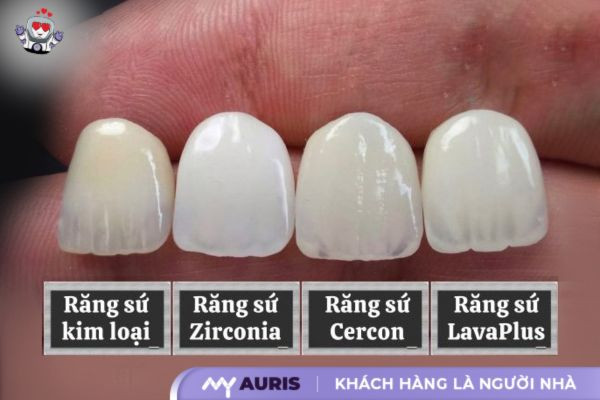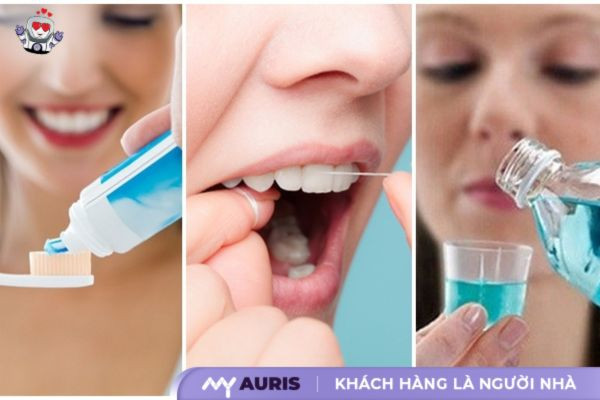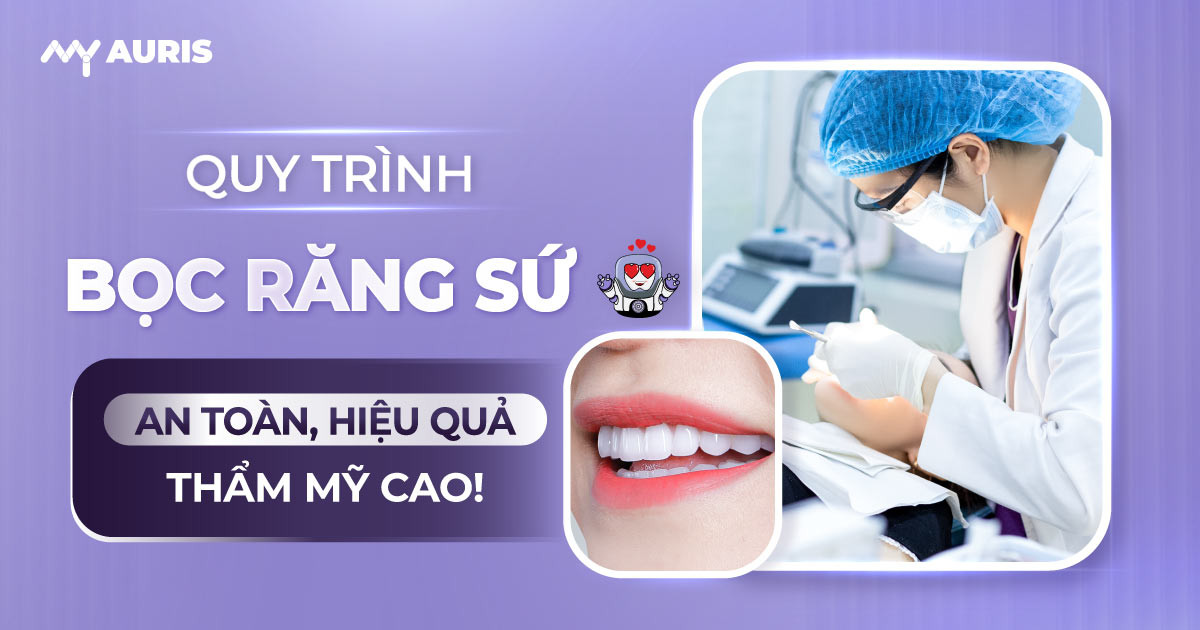Ceramic dental crowns are a popular tooth restoration method, helping restore function and aesthetics to damaged, decayed, broken or discolored teeth. The porcelain crown process includes many steps, from examination and consultation to porcelain crown placement. To better understand this process, you can refer to detailed information from My Auris Dental.
Learn about cosmetic porcelain teeth
Ceramic crowns are a popular method of tooth restoration, Used to restore function and aesthetics to damaged, decayed, broken or discolored teeth. This process includes many steps, from examination and consultation to placing porcelain teeth. The porcelain crown cosmetic procedure can last from 2-3 weeks, depending on the complexity of the case.
What is cosmetic porcelain crown?
Aesthetic porcelain crowns are a dental technique for the purpose of tooth aesthetics that use porcelain crowns to completely cover the damaged tooth surface. Porcelain crowns are made from dental materials such as zirconia ceramic, metal ceramic, metal-free ceramic or bonded ceramic. Porcelain crowns can help restore function, improve aesthetics and protect teeth from further damage.
Ceramic crowns are part of the dental restoration process, helping to restore the shape, size, color and function of damaged teeth. Porcelain crowns are an effective solution for dental problems such as:
- Rotten, broken teeth
- Discolored, dull teeth
- Tooth wear and sensitivity
- Misaligned, protruding, underbite teeth

Advantages and disadvantages of porcelain crown
Advantages:
- High aesthetics: Porcelain teeth have natural colors, helping to improve smile aesthetics.
- Durable: Porcelain teeth are highly durable, can be used for a long time.
- Abrasion resistant: Porcelain teeth do not wear out like real teeth, helping to protect teeth from damage more.
- Anti-discoloration: Porcelain teeth do not change color like real teeth, retain their natural color over time.
Disadvantages:
- Possibility of peeling: Porcelain teeth can peel if not cared for properly.
- Not possible repair: Broken or chipped porcelain teeth need to be replaced.
How many steps does the cosmetic porcelain crown process include?
Ceramic crowns are a dental technique performed to restore damaged or discolored teeth. The porcelain crown process is usually performed in many steps, which can last from 2 to 3 weeks, depending on the complexity of the case, we will learn about each step in detail.
Examination and consultation
The first step in the porcelain crown process is examination and consultation. The dentist will check your oral condition, take X-rays and discuss your wishes. about the aesthetics and function of your teeth. The dentist will provide you with information about the types of porcelain teeth, the pros and cons of each type, the cost and implementation time. You need to ask questions and discuss openly with the dentist to clearly understand the process and make an appropriate decision.
Teeth preparation
After examination and consultation, the dentist will prepare the teeth for porcelain crowns. This step may cause mild or no pain, depending on the condition of your teeth. The dentist will grind the teeth and shape them to fit the porcelain crown. The tooth grinding process requires careful care. Highly professional skills of the dentist to ensure that the teeth are ground sufficiently, without causing damage to the surrounding tooth tissue.
Taking tooth impressions
After Once the tooth has been prepared, the dentist will take an impression of the tooth to create a mold for the porcelain crown. This process is usually done using silicon or alginate material. The impression will be sent to the lab to make the porcelain crown.

Making porcelain teeth
At the lab, porcelain crowns will be made according to your tooth impressions. The process of manufacturing porcelain crowns requires high techniques and modern technology to ensure the porcelain crowns are accurate, fit closely with real teeth, have natural colors and are highly durable. The type of material used to make porcelain crowns will depend on your choice and your dentist’s advice.
Ceramic crown
After the porcelain crown is manufactured, the dentist will proceed to attach the porcelain crown to the real tooth. The dentist will check the fit of the porcelain crown to the real tooth and use specialized glue to attach the porcelain crown to the tooth. After attaching the porcelain crown, the dentist will polish and check the aesthetics and function of the tooth.

Steps to care for porcelain teeth after cover
Caring for porcelain teeth after covering is very important to maintain the effectiveness and longevity of porcelain teeth. You should clean your teeth every day with a toothbrush, toothpaste and dental floss. You should see a dentist every 6 months to check the condition of your porcelain teeth and you should avoid bad habits such as grinding your teeth, biting your nails, chewing hard objects.
Types of porcelain crowns
Porcelain dental crowns are a popular solution to restore damaged teeth, improve aesthetics and protect teeth from further damage. Currently, there are many types of porcelain teeth used in dentistry, each with its own advantages and disadvantages suitable for each specific case.

Zirconium porcelain crowns
Zirconium porcelain crowns are the most popular type of porcelain crowns today because of their high durability, good wear resistance and natural color. Zirconia is a type of ceramic with high hardness, scratch resistance and color durability, allowing zirconia porcelain teeth to be used for a long time without changing color. However, the cost of zirconia porcelain teeth is higher than other types of porcelain teeth.
| Advantages | Disadvantages |
|---|---|
| High durability, good wear resistance | High cost |
| Natural color, highly aesthetic | High technical requirements in manufacturing create |
| Resistant to discoloration, durable over time | |
| Does not irritate gums | |
| Body-friendly |
Metal porcelain crowns
Metal porcelain crowns are the most popular type of porcelain crowns in the past because of their low cost and high durability. However, this type of porcelain teeth has the disadvantage that the metal color can be exposed at the tooth edges, causing loss of aesthetics, and can cause gum irritation.
| Advantages | Disadvantages |
|---|---|
| High durability, good wear resistance | Metal color can be exposed at the tooth edges, causing loss of aesthetics cosmetic |
| Low cost | May cause gum irritation |
Lava Plus porcelain crown
Teeth Lava Plus porcelain is a type of porcelain tooth made from lithium disilicate ceramic material, known for its durability, high aesthetics and good bearing capacity
| Features | Advantages | Disadvantages |
|---|---|---|
| Aesthetics | Natural color, transparent, similar to real teeth, creating natural beauty for a smile. | None |
| Durability | Good bearing capacity, high abrasion resistance, less affected by harmful agents from food and water | None |
| Price | Compared to other types of porcelain teeth, Lava Plus has a high price more. | |
| Technical | Requires high skills of doctors and technicians to ensure accuracy and effectiveness. |
Ceramic crowns Cercon
Cercon porcelain teeth are made from full ceramic, do not contain metal, so they do not irritate the gums, have a natural color and are more aesthetically pleasing than porcelain metal teeth. However, the cost of Cercon porcelain teeth is higher than that of ceramic metal teeth.
| Advantages | Disadvantages |
|---|---|
| Natural color, highly aesthetic | Lower durability than zirconia porcelain teeth |
| Does not cause gum irritation | Cost high |
| Body-friendly |
Cost of cosmetic porcelain teeth
Ceramic crowns are a popular tooth restoration solution, bringing many aesthetic and functional benefits. However, the cost of porcelain crowns is one of the factors that makes many people wonder. The cost of porcelain crowns depends on many factors, including the type of porcelain crown, technique used, location and dentist.
Factors affecting cost
- Type of porcelain teeth: Each type Porcelain teeth have different materials and manufacturing technologies, so the cost is also different. Zirconia porcelain teeth have the highest cost, followed by metal-free porcelain teeth, porcelain-ceramic teeth and porcelain-bonded teeth have the lowest cost.
- Number of coated teeth: The cost of porcelain crowns will increase with the number of teeth. covered.
- Performance technique: Porcelain crown technique requires high skills of the dentist, if advanced techniques are used, the cost will be higher.
- Actual location Currently: The cost of porcelain crowns at reputable dental clinics using modern technology will be higher than at small clinics.
- Dentist: The skill and experience of the dentist also affects the cost of porcelain crowns. Highly skilled dentists with extensive experience will have higher fees.
Price comparison table for porcelain crowns
Below is a price comparison table of some popular types of porcelain teeth:
| Type of porcelain teeth | Price (VND) | Advantages | Disadvantages |
| Zirconium ceramic teeth | 1,500,000 – 3,000,000 | High durability, good wear resistance, high aesthetics | Cost high |
| Cercon porcelain teeth | 1,500,000 – 4,000,000 | Highly aesthetic, does not cause irritation gums | Lower durability than zirconia |
| Porcelain metal teeth | 1,000,000 – 2,000,000 | High durability, low cost | Metallic color can show through at the edge of the teeth, causing gum irritation |
| Ceramic teeth Lava | 1,500,000 – 3,500,000 | Highly aesthetic, does not irritate gums | High price |
Tooth care after cosmetic porcelain crowns
Porcelain crowns are an effective solution to restore function and aesthetics to damaged teeth. After porcelain crowns, proper care of porcelain teeth is very important to maintain the effectiveness and longevity of porcelain teeth. Taking care of porcelain teeth is not difficult, you just need to pay attention to a few things:
Daily oral hygiene
- Brush your teeth regularly: You should brush your teeth at least Twice a day, use a soft toothbrush and toothpaste containing fluoride. Choose a toothbrush with a small head that can easily reach between teeth.
- Use dental floss: Dental floss helps remove food particles stuck between teeth, where toothbrushes cannot reach. You should use dental floss at least once a day.
- Use mouthwash: Mouthwash eliminates bacteria and cleans the oral cavity, helping to maintain fresh breath id=”attachment_50003″ aria-describedby=”caption-attachment-50003″ style=”width: 600px” class=”wp-caption aligncenter”>

Clean teeth after porcelain crown Regular check-ups
After getting porcelain crowns, you should see a dentist every 6 months to check the condition of the porcelain teeth and detect early problems that arise. The dentist will check the fit of the porcelain crown to the real tooth, check the condition of the gums, and give you advice on how to effectively care for porcelain teeth.
Avoid bad habits
- Teeth grinding: Teeth grinding can cause wear and tear. You should use a tooth protector when you sleep if you grind your teeth at night.
- Nail biting: Biting your nails can cause porcelain teeth to break.
- Chewing hard objects: Chewing hard objects can break porcelain teeth. You should avoid chewing hard objects such as rocks, pebbles, and hard fruit stems.
- Using teeth to open things: Use teeth to open objects. Opening things can break porcelain teeth. You should use specialized tools to open things.
Compare porcelain crowns with other tooth restoration methods
Ceramic crowns are one of the popular tooth restoration methods, but there are also many other methods such as porcelain bridges, dental implants, braces and tooth fillings. To choose the appropriate tooth restoration method, you need to understand the pros and cons of each method.
Comparing porcelain crowns with porcelain bridges
Porcelain crowns: Porcelain crowns are used to restore a damaged, decayed tooth. broken, or discolored.
Ceramic dental bridge: Porcelain dental bridge is used to restore one or more missing teeth, by attaching a porcelain bridge to two adjacent teeth.
Compare:
Specialties points Ceramic crown Ceramic bridge Application Restoring a damaged tooth Restoring one or more lost teeth Advantages Highly aesthetic, durable, wear-resistant Highly aesthetic, durable sure Disadvantages Needs tooth grinding Can cause damage to adjacent teeth Cost High High Ceramic crowns are suitable for restoring a damaged tooth. Bridge Porcelain teeth are suitable for restoring one or more lost teeth, if the two adjacent teeth are healthy enough to serve as abutments.
Compare porcelain crowns with dental implants
Ceramic dental crowns: Porcelain dental crowns are used to restore a damaged tooth.
Dental implants: Dental implants are used to restore lost teeth, by implanting an artificial tooth root into the jawbone, then attaching a crown. Porcelain teeth on top.
Compare:
Features Ceramic crowns Dental implants Applications Restoring a damaged tooth Restoring a lost tooth Advantages Highly aesthetic, durable, resistant wear Durable, does not cause damage to adjacent teeth Disadvantages Need to grind teeth High cost, long implementation time Cost High Very High Porcelain dental crowns are suitable for restoring a damaged tooth. Dental implants are suitable for restoring lost teeth, if your jawbone is strong enough to implant the tooth root.
Compare porcelain crowns with braces
Ceramic crowns: Porcelain crowns are used to restore a damaged tooth.
Braces: Braces are used to correct misaligned, protruding, underbite teeth, using brackets and wires. bow.
Compare:
Features Ceramic crowns Braces Applications Restoring a damaged tooth Correcting misaligned, protruding, underbite teeth Advantages Highly aesthetic, durable, wear-resistant Highly effective, painless Disadvantages Needs tooth grinding Expensive time Cost High High Porcelain dental crowns are suitable for restoring a damaged tooth. Braces are suitable for cases where teeth are misaligned, protruding, or underbite, and do not affect oral health.
Compare porcelain crowns with dental fillings
Ceramic crowns: Porcelain crowns are used to restore a damaged, decayed, broken, or discolored tooth.
Tooth fillings: Dental fillings are used to restore decayed teeth, by using filling material to fill the damaged part of the tooth. deep.
Compare:
Features Ceramic crowns Tooth fillings Applications Restoring damaged, decayed, broken, or discolored teeth Restoring cavities Advantages Aesthetics high, durable, wear-resistant Low cost, fast Disadvantages Needs tooth grinding Not as durableother methods Cost High Low Porcelain dental crowns are suitable for restoring teeth that are severely damaged, decayed, broken, or discolored. Dental fillings are suitable for restoring teeth with mild decay.
The porcelain crown process includes many steps, from examination and consultation to porcelain crown placement. To ensure effectiveness and safety, you should choose a reputable dental clinic with a team of professional dentists and modern equipment. My Auris Dental is proud to be a reputable dental address, always putting customers’ health and aesthetics first, with the motto “customers are family”. Please contact My Auris Dental Clinic for advice and effective porcelain crowns.
Duong Duong






